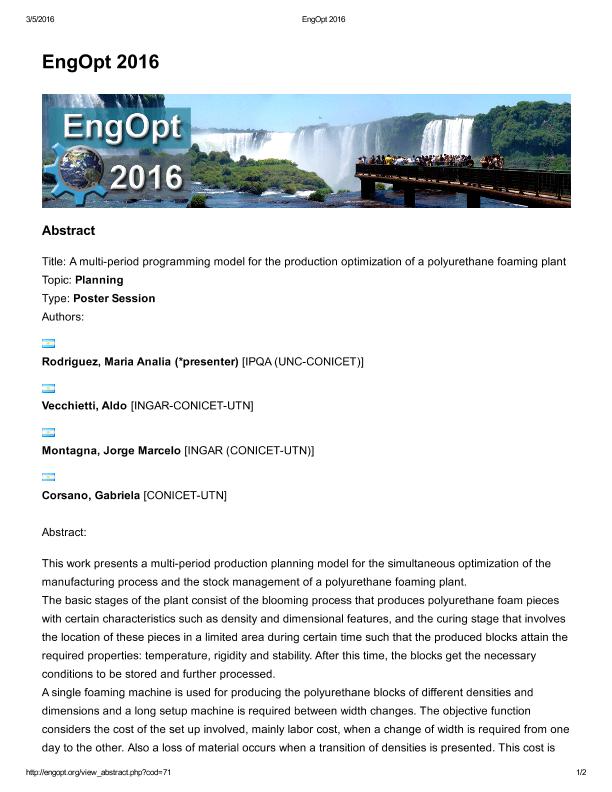Evento
A multi-period programming model for the production optimization of a polyurethane foaming plant
Tipo del evento:
Conferencia
Nombre del evento:
5th International Conference on Engineering Optimization
Fecha del evento:
19/06/2016
Institución Organizadora:
Universidad Federal de Río de Janeiro;
Título del Libro:
Proceedings of Engineering Optimization Conference EngOpt 2016
Editorial:
Universidad Federal de Río de Janeiro
ISBN:
978-85-7650-522-8
Idioma:
Inglés
Clasificación temática:
Resumen
This work presents a multi-period production planning model for the simultaneous optimization of the manufacturing process and the stock management of a polyurethane foaming plant. The basic stages of the plant consist of the blooming process that produces polyurethane foam pieces with certain characteristics such as density and dimensional features, and the curing stage that involves the location of these pieces in a limited area during certain time such that the produced blocks attain the required properties: temperature, rigidity and stability. After this time, the blocks get the necessary conditions to be stored and further processed.A single foaming machine is used for producing the polyurethane blocks of different densities and dimensions and a long setup machine is required between width changes. The objective function considers the cost of the set up involved, mainly labor cost, when a change of width is required from one day to the other. Also a loss of material occurs when a transition of densities is presented. This cost is included in the objective function. In summary, the model performance measure takes into account the cost of width and density changes in the production plan and penalizes unsatisfied demand and unfulfilled safety stock.Due to the volume of the foam pieces and the limited area of the curing step and the final storage, an efficient stock management is crucial in order to minimize costs and satisfy demand; and that is the reason to include those decisions in the production planning model. As it was mentioned, a multi-period approach is considered where the production requirements based on the estimated demand are known. The proposed model provides a detailed production program for a set of days selected by the manager, while a more general plan is obtained for the rest of the days of the planning horizon, in an overall multi-period formulation. The detailed program includes information about how to place the foamed blocks in the curing area taking into account precedence constraints. The purpose of the first part of the plan is to facilitate the production decisions on the plant floor considering all relevant constraints involved in the process. On the other hand, the approximated production plan, determined for the rest of the days in the planning horizon, gives information to estimate raw material purchases, labor requirements and operational costs, among others. In addition, for each day in the planning horizon, the model determines the blocks to be foamed and the inventory management. Several relations among the problem stages and the involved decisions are assessed; therefore a Generalized Disjunctive Programming (GDP) approach allows a clear outline of the simultaneous optimization problem. GDP provides a quantitative and qualitative framework to formulate the problem and their relationships in a natural way. Different study cases are solved which represent typical plant floor scenarios and their solutions are compared, in order to assess the model capabilities and facilitate the decision-making of the company.
Palabras clave:
MULTI-PERIOD PLANNING
,
POLYURETHANE FOAMING PLANT
,
MILP
Archivos asociados
Licencia
Identificadores
Colecciones
Eventos(INGAR)
Eventos de INST.DE DESARROLLO Y DISEÑO (I)
Eventos de INST.DE DESARROLLO Y DISEÑO (I)
Eventos(PLAPIQUI)
Eventos de PLANTA PILOTO DE INGENIERIA QUIMICA (I)
Eventos de PLANTA PILOTO DE INGENIERIA QUIMICA (I)
Citación
A multi-period programming model for the production optimization of a polyurethane foaming plant; 5th International Conference on Engineering Optimization; Cataras del Iguazú; Brasil; 2016; 1-2
Compartir




